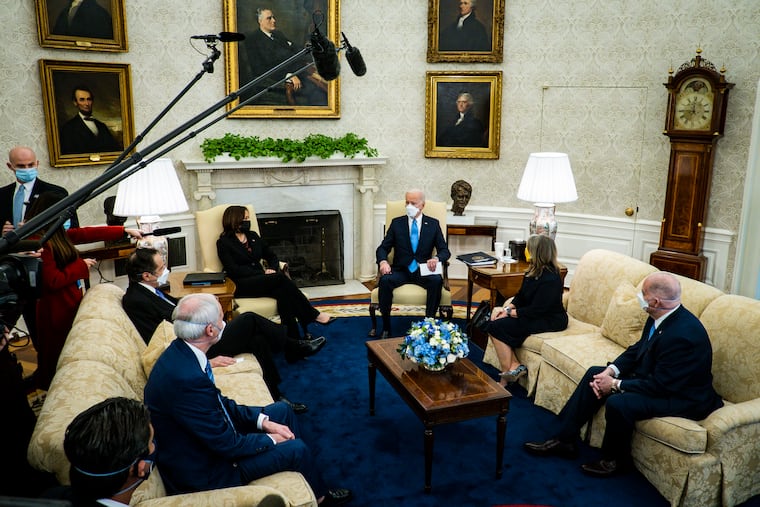Why Biden’s rescue plan makes sense and how it can be better targeted | Moody’s Mark Zandi
The president’s plan includes a third round of stimulus checks that go to those making up to $100,000 a year. That’s too high.

Fingers crossed, but the end of the pandemic is coming into view. Vaccinations have picked up. Current trends suggest the nation will achieve herd immunity by July 4. The advent of a more problematic strain of the virus could derail this optimism, but so far so good.
The economy also appears poised to take off as the pandemic winds down. Many Americans have been self-quarantined more or less since the pandemic struck a year ago. We haven’t been traveling, or going to restaurants or ball games. We are raring to do all these things, once we are confident that we won’t get sick.
Many middle-income and especially high-income households have the wherewithal to get out and spend the cash that piled up in their checking accounts while they were stuck at home. Financial support coming from the federal government during the pandemic, such as the stimulus checks, has also gone into savings or to pay down credit-card and other debt. All this cash and pent-up demand will fuel a surge in spending later this year.
The economy will also be supercharged by the large $1.9 trillion American Rescue Plan that the Biden administration and Democratic-controlled Congress appear set to agree on. This will be the third large relief package from Washington since the pandemic hit.
The Biden plan is so large that there is mounting concern it is too large. That is, the economy might grow so strongly over the next year or so, create so many jobs, and drive unemployment so low that inflation will quickly become a problem.
Wow. This is putting the cart before the horse! The national unemployment rate is still painfully high at more than 6%. It was about half this just before the pandemic. And this doesn’t count the millions of workers forced out of the job market altogether by the pandemic to take care of children who aren’t at school or sick family members.
This also doesn’t consider how high unemployment is among minority groups and those with lesser skills and education. The Black unemployment rate is more than 9% and closer to 13% when considering those pushed out of the workforce. Workers with less than a high school degree also have an unemployment rate exceeding 9% — 14%, including those out of the workforce.
» READ MORE: Federal Reserve chair says economic recovery is incomplete, higher inflation unlikely
So, we are a long way from having to worry about inflation becoming too strong. Besides, our biggest worry for years has been painfully low inflation. The Federal Reserve Board would like to see consistent 2% inflation, but we haven’t had that for almost a quarter-century.
Another criticism of President Joe Biden’s American Rescue Plan is that it will add significantly to the nation’s deficits and mounting debt load. Pre-pandemic, the national debt was about 75% of GDP. Given all the fiscal support during the pandemic, including Biden’s plan, the debt load will increase to 110% of GDP, the highest ever in history.
But the nation’s deficits and debt load would be even larger if not for all the help from the federal government. Without the support, the economy would have completely cratered, unemployment would still be in the double-digits, and the government’s fiscal situation would be even worse than it is. Moreover, with interest rates about as low as they have ever been, it has never been cheaper for the government to borrow money.
This said, once everyone is fully employed, hopefully sometime next year, lawmakers must focus on the nation’s fiscal challenges. At the very least, this means any new ongoing government spending initiative should be paid for. Fortunately, this appears to be what Biden has in mind. During his campaign, Biden proposed more funding for health care, education, child care and housing and said it should be paid for with higher marginal tax rates on corporations and the well-to-do.
A reasonable critique of the American Rescue Plan is that it could be designed to more effectively help those in need. The plan includes a third round of stimulus checks that go to those making as much as $100,000 a year. That’s too high. Much of the second round of stimulus checks didn’t help families meet their expenses but ended up in savings and to paying down debt. Not bad things, but not what the funds were intended for.
Also under the plan, state and local governments get hundreds of billions of dollars to help fill their budget shortfalls. However, it is clear that the funds they’d get would cover the shortfalls three times over. Only about a dozen states even have a significant budget shortfall. It would be better to scale back this support and redirect the funds to policies more helpful in getting everyone back to work quickly. Infrastructure immediately comes to mind.
There are smaller things to quibble with in the American Rescue Plan. But if lawmakers soon put those quibbles aside and pass the legislation, the economy will soon be off and running. Fingers crossed.